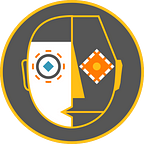Why NFTs are much more than digital art, they are your digital identity
Sometimes I feel that our digital sense of identity has already surpassed our physical sense of identity in terms of importance. This holds true, particularly among younger generations. Nowadays, having an Instagram-worthy photo of a moment seems to be more important than the moment itself. And the trend will only accelerate, not go back. In the near future, our identity will most likely be fully digital. Who you are online will be more important than who you are at home and in the physical world.
Your digital identity will serve as the window to your soul for the outside world. It is the first thing people associate you with. Hashmasks is designed to serve as the portrait of your digital identity. And your name will be engraved in its contracts as long as the internet and Ethereum continue to exist.
Digital art existed long before the blockchain. But just like almost all data, it was easy to copy. How can you claim a digital artwork is yours if another person can present you with the identical file of the image? Ethereum solves this problem by storing the ownership on-chain in a non-fungible token (NFT) and, thus, presents an easy way to verify ownership of digital art. The NFT market is still very much in its infancy and the amount of digital art is limited. We imagine a future, in which only a small proportion of the world will physically visit the Louvre. The rest of us will enter the second world and visit the digital Louvre. And in there, you will see the Mona Lisa and famous works by DaVinci. And you will also see the Cryptopunks and Autoglyphs hang in the long corridors of digital Louvre, as they are the first artworks stored and generated on-chain, respectively.
And the Hashmasks will hang in the same corridor as one of the largest collaborative art project created by over 70 artists globally in the early exploration phase of NFTs. The first digital artwork that created an internal market for names, allowing the consumer of the art to shape the rarity of the individual art portraits. It represents a prime example of using the blockchain to its fullest potential. Hashmasks incorporates two token models that are easy-to-understand and use the blockchain in its intended way. Most blockchain applications on Ethereum struggle to find one token model, often slipping into redundant governance or payment token models with extremely low participation.
Hashmasks have two well defined token models. The NFT allows the ownership to be stored on the blockchain in order to allow the transparent verification and transfer of ownership over the art. Every single owner, sale, offer, bid and movement of each portrait will be publicly verifiable and immutable on Ethereum and leave its mark on the back of the digital canvas. The Name Changing Token (NCT) enables users to name their NFTs within the Hashmasks ecosystem and, thus, commoditizes the name-giving process itself.
In order to assign rarity to names, we enforced a few rules. The most important ones are:
- Each name has to be unique
- You need to hold the NFT for approximately 1/2 year in order to accumulate enough NCTs (1,830) to change the name of your NFT ones
Here is the fun: We provide you with a few guidelines so that you have an approximate idea of the rarity of each NFT. However, there are many traits that are unaccounted for and we have included other elements that allow you to create your own sub-collections within the large collection. If you look closely, you can find them. But above all, the rarest of all traits will be the names. And you can name your NFT once you purchase your NFT. You also get an additional 1/2 year supply of NCTs, so you have a bit of firepower to play around with.
On Thursday, 28 Jan 2020 at 16:00 (CEST) the Hashmask art collectible comes to life. You can see the full collection on the website, but the distribution is conducted randomly. Only after 14 days, every participant will know which Hashmasks they got.
